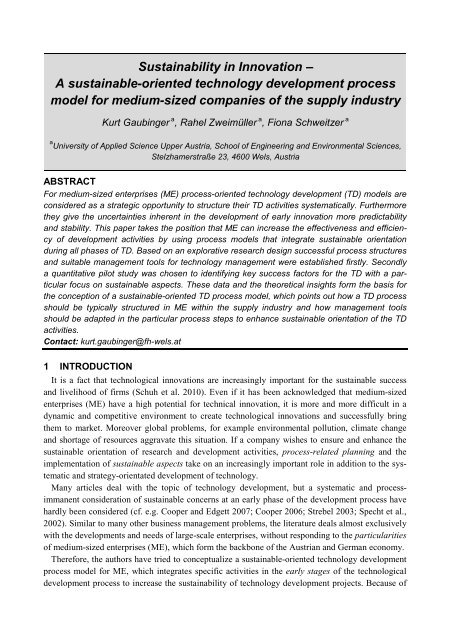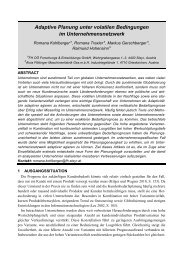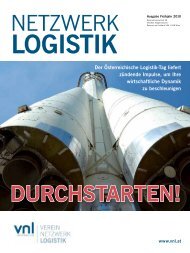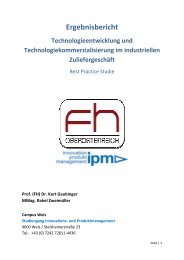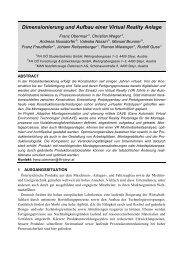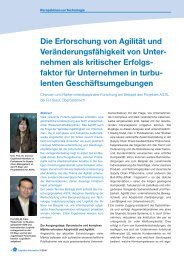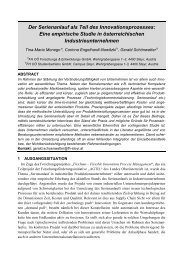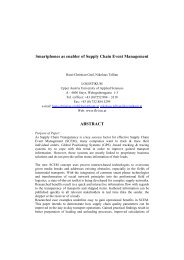a sustainable-oriented technology - agtil
a sustainable-oriented technology - agtil
a sustainable-oriented technology - agtil
You also want an ePaper? Increase the reach of your titles
YUMPU automatically turns print PDFs into web optimized ePapers that Google loves.
Sustainability in Innovation –<br />
A <strong>sustainable</strong>-<strong>oriented</strong> <strong>technology</strong> development process<br />
model for medium-sized companies of the supply industry<br />
Kurt Gaubinger a , Rahel Zweimüller a , Fiona Schweitzer a<br />
a University of Applied Science Upper Austria, School of Engineering and Environmental Sciences,<br />
Stelzhamerstraße 23, 4600 Wels, Austria<br />
ABSTRACT<br />
For medium-sized enterprises (ME) process-<strong>oriented</strong> <strong>technology</strong> development (TD) models are<br />
considered as a strategic opportunity to structure their TD activities systematically. Furthermore<br />
they give the uncertainties inherent in the development of early innovation more predictability<br />
and stability. This paper takes the position that ME can increase the effectiveness and efficiency<br />
of development activities by using process models that integrate <strong>sustainable</strong> orientation<br />
during all phases of TD. Based on an explorative research design successful process structures<br />
and suitable management tools for <strong>technology</strong> management were established firstly. Secondly<br />
a quantitative pilot study was chosen to identifying key success factors for the TD with a particular<br />
focus on <strong>sustainable</strong> aspects. These data and the theoretical insights form the basis for<br />
the conception of a <strong>sustainable</strong>-<strong>oriented</strong> TD process model, which points out how a TD process<br />
should be typically structured in ME within the supply industry and how management tools<br />
should be adapted in the particular process steps to enhance <strong>sustainable</strong> orientation of the TD<br />
activities.<br />
Contact: kurt.gaubinger@fh-wels.at<br />
1 INTRODUCTION<br />
It is a fact that technological innovations are increasingly important for the <strong>sustainable</strong> success<br />
and livelihood of firms (Schuh et al. 2010). Even if it has been acknowledged that medium-sized<br />
enterprises (ME) have a high potential for technical innovation, it is more and more difficult in a<br />
dynamic and competitive environment to create technological innovations and successfully bring<br />
them to market. Moreover global problems, for example environmental pollution, climate change<br />
and shortage of resources aggravate this situation. If a company wishes to ensure and enhance the<br />
<strong>sustainable</strong> orientation of research and development activities, process-related planning and the<br />
implementation of <strong>sustainable</strong> aspects take on an increasingly important role in addition to the systematic<br />
and strategy-orientated development of <strong>technology</strong>.<br />
Many articles deal with the topic of <strong>technology</strong> development, but a systematic and processimmanent<br />
consideration of <strong>sustainable</strong> concerns at an early phase of the development process have<br />
hardly been considered (cf. e.g. Cooper and Edgett 2007; Cooper 2006; Strebel 2003; Specht et al.,<br />
2002). Similar to many other business management problems, the literature deals almost exclusively<br />
with the developments and needs of large-scale enterprises, without responding to the particularities<br />
of medium-sized enterprises (ME), which form the backbone of the Austrian and German economy.<br />
Therefore, the authors have tried to conceptualize a <strong>sustainable</strong>-<strong>oriented</strong> <strong>technology</strong> development<br />
process model for ME, which integrates specific activities in the early stages of the technological<br />
development process to increase the sustainability of <strong>technology</strong> development projects. Because of
the commercial relevance of medium-sized companies within the supply industry in Austria and<br />
Germany, the conceived framework specifically targets the particularities of this industry.<br />
2 THEORETICAL FOUNDATIONS<br />
2.1 Technology Development and Process Orientation<br />
In many cases the outcome of <strong>technology</strong> development (TD) projects exhibit new correlation effects<br />
between the natural sciences and technical advancement (Strebel 2003) and therefore TD<br />
projects are often undirected, unfocused and more indistinctly defined than are product development<br />
projects (Cooper et al. 2002; Vahs and Burmester 2005). In this context Cooper (2006) emphasizes,<br />
that TD projects – where the outcome is new knowledge, a new technical capability or even a <strong>technology</strong><br />
platform (Cooper 2009) - are often the foundation or platform for new products of the company<br />
or of their customers. Some authors sub-divide the TD activities into the actual <strong>technology</strong><br />
development (“applied research”) and into the so-called advance development (Specht et al. 2002;<br />
Macharzina 2003). In principle, the advance development is responsible for application-<strong>oriented</strong><br />
further development of new technologies with regard to products and processes of the next or nextbut-one<br />
generation and in many cases the outcome of these activities are related prototypes (Diehlmann<br />
1998). Even though TD projects represent a small proportion of effort in the typical company´s<br />
development activities, they are often vital to the company´s growth and survival. Therefore<br />
TD projects have to be selected and managed in a systematic and focused way throughout a welldefined<br />
process model (Cooper 2006). One of the principal objectives of process models is to structure<br />
typical tasks in the corresponding field to ensure the targeted application of work techniques,<br />
methods and tools (Gaubinger et al. 2009). A well-defined process is transparent for all departments<br />
and a common understanding can be developed which eases communication within the company.<br />
Empirical studies (Cooper 2001) show that companies using a well-executed development process,<br />
are more successful than companies lacking a systematic approach. Because TD projects are quite<br />
different in terms of risk, uncertainty, scope and cost from typical new product development<br />
projects (Specht et al. 2002; Cooper 2009), these processes have to be different from traditional new<br />
product development processes.<br />
There exist a vast number of models which describe the “ideal” product development process (e.g.<br />
Cooper 1988; Thom 1980; Geschka 1993; Pleschak and Sabisch 1996; Vahs and Burmester 2005;<br />
Gaubinger 2009). They vary with regard to the degree of detail, the priorities and the perspective.<br />
However, Cooper expanded his product development process model to the so-called front end of<br />
innovation (Cooper 2008) and subsequently extended his scope to include systematic TD, which<br />
“feed the new product development process” (Cooper 2009). He “bolted on” the so-called “Stage-<br />
Gate TD process” which consists of three Stages and four Gates (Cooper 2006). The trigger for<br />
every TD process is an idea, which is the outcome of the preliminary stage “Discovery”. The first<br />
Gate in Cooper´s model is the idea screen where the decision is taken to commit a limited amount of<br />
time and money to the research project. The purpose of the first Stage is to build the foundation for<br />
the research project (Cooper 2006).<br />
In the second Gate a decision is made to begin limited experimental or technical work in the next<br />
Stage. The purpose of the following Stage 2 is to demonstrate the technical feasibility of the idea<br />
under laboratory conditions. Schuh et al. (2010) point out the increasing importance of joint TD<br />
within intercompany networks caused by rapid further development of technologies and the increasing<br />
importance of interdisciplinary issues.
In the next Gate a decision has to be taken in order to further develop the TD project. The next<br />
Stage is the so-called “Detailed Investigation” where a fully experimental plan is implemented and<br />
the technological feasibility is proofed (Cooper 2006). Moreover, the scope of the <strong>technology</strong> and<br />
its value to the company has to be defined. The final Gate is called “Application Path” and the results<br />
of technical work are reviewed at that point. The decision has to be taken how the <strong>technology</strong><br />
will be exploited in detail and how new product projects could be initiated. Cooper points out in his<br />
current publications that the TD process should be iterative and feature loops both within Stages<br />
and potentially also to previous Stages (Cooper 2008; Cooper 2009).<br />
2.2 Sustainable-<strong>oriented</strong> Innovation Management<br />
Environmental and social challenges are increasingly affecting businesses in many industries, besides<br />
the ongoing trend towards aggravated global competition. Due to this, the necessity of developing<br />
<strong>sustainable</strong> products is one of the key challenges facing companies in the 21st century (Maxwell<br />
and Van der Vorst 2003).<br />
The concept of sustainability goes back to the so-called Brundtland Report wherein Sustainable<br />
Development is defined as “development that meets the needs of the present without compromising<br />
the ability of future generations to meet their own needs” (Brundtland Commission 1987). Transposing<br />
this idea to the business level, corporate sustainability can be defined as meeting the needs of<br />
a firm´s present and future stakeholder, such as shareholders, employees, clients, pressure groups<br />
etc. (Dyllick and Hockerts 2002). To this end, focusing on short-term profits is not enough to survive<br />
in this challenging environment, because stakeholders expect firms to create economic, environmental<br />
and social value. Elkington (1997) emphasizes, that these three dimensions are interrelated<br />
and they may influence each other in multiple ways. Future-<strong>oriented</strong> and visionary companies<br />
have to seek new approaches to integrate their chase of economic prosperity with the guarantee<br />
for environmental protection and social well-being for current and future generations (Placet et al.<br />
2005).<br />
There is wide agreement that the challenges of sustainability conceal risks, but also offer a significant<br />
potential for innovation and related business opportunities (Hansen et al. 2009). Therefore<br />
sustainability aspects must be considered systematically at all stages of the innovation management<br />
process and particularly already in the early stages of the process, the so-called “front end of innovation”.<br />
To structure and asses the sustainability effects of innovations and therefore to better inform<br />
management about the search focus for <strong>sustainable</strong> motivated innovation activities, Hansen et<br />
al. (2009) have conceptualized a model termed the “Sustainable Innovation Cube” (SIC), which is<br />
defined by the three main-dimensions, which are each divided into three sub-dimensions. Therefore<br />
the SIC unfolds into 27 individual areas in which sustainability effects may occur and which can be<br />
regarded as targets to be addressed by innovation management. Additionally the SIC model implies<br />
an assignment of sustainability assessment methods to the 27 SIC areas, which guides companies to<br />
the right choice of assessment tools (Hansen et al. 2009).<br />
The authors of this article assert that only companies, which define sustainability as a main strategic<br />
goal, will gain a competitive advantage; but, not without difficulty. Nidumolu et al. (2009)<br />
point out, that most companies go through five stages on the path to becoming <strong>sustainable</strong>. At each<br />
stage companies face different challenges and must develop new competencies to exploit the stagespecific<br />
innovation opportunities (Nidumolu et al. 2009). The range reaches from the awareness that<br />
environmental regulations and norms become an opportunity for innovations via a stronger awareness<br />
of efficiency-aspects throughout the value chain (Hansen et al. 2002) and the development of
<strong>sustainable</strong> products and services the development of new business models. To do this, existing<br />
models must be questioned and new delivery mechanisms must be developed. Stage five goes even<br />
further introducing “next-practice-platforms” which change existing paradigms.<br />
2.3 Innovation Performance of Small and Medium-sized Companies<br />
Small to medium-sized enterprises (SMEs) dominate the manufacturing sector of most Western<br />
economies (Larsen and Lewis 2007) and are considered to have a high potential for innovation<br />
(Blessin 2001). On the one hand, this high potential can be explained by the dual function of business<br />
owners, who also serve in management roles. This frequently allows for the speedy realization<br />
of innovation projects (Schwarz et al. 2006). On the other hand the direct customer contact, a flat<br />
organizational structure and a flexible production ease a rapid transfer of ideas into marketable<br />
technologies, products and services (Herstatt et al. 2001). However, it should be considered, that<br />
this high potential for innovation can only be realized, if SMEs plan and realize their innovation<br />
projects systematically. This aspect is one of the key innovation-related weaknesses of SMEs. Pfohl<br />
and Kellerwessel (1990) contend that SMEs differ greatly from large-scale enterprises with regard<br />
to their poor planning at the management level. This weakness is also transferred to innovation<br />
activities. On the basis of an integrated analysis from a variety of sources, Herstatt et al. (2001)<br />
conclude, that in particular long-term innovation planning systems are underdeveloped in SMEs.<br />
Unsystematic information procurement related with poor recognition of market trends and technological<br />
trends are also major weaknesses in this context. Moreover, typical problems of SMEs with<br />
regard to their innovation processes are the greater financial constraints and the manpower bottlenecks<br />
in terms of too few or inadequately qualified personnel (Pullen et al. 2009).<br />
In order to reduce the weaknesses mentioned above, SMEs have to implement an open and multifunctional<br />
innovation process (Gaubinger and Werani 2007), which enable strategy-driven and<br />
efficient <strong>technology</strong> and product development activities. Because of their specific situations and<br />
restrictions, SMEs should use only a manageable number of innovation management tools, which<br />
have a low level of application complexity, within their innovation activities.<br />
3 RESEARCH QUESTIONS AND METHODOLOGY<br />
To establish a <strong>sustainable</strong>-<strong>oriented</strong> <strong>technology</strong> development framework for ME in the supply industry,<br />
the following questions have to be answered: Which steps are crucial to the process of sustainability-<strong>oriented</strong><br />
<strong>technology</strong> development in ME in the supply industry, and what tools and<br />
methods should be applied to the individual process steps in a sustainably-orientated <strong>technology</strong><br />
development process?<br />
To answer the research questions, two studies were carried out. First, an explorative research design<br />
was used to ascertain successful process structures and suitable management tools for <strong>technology</strong><br />
management (study 1). Afterwards a quantitative pilot study was carried out to identify key<br />
success factors for the TD with a particular focus on <strong>sustainable</strong> aspects (study 2).<br />
3.1 Study 1<br />
The aim of Study 1 was to identify the structures and contexts of <strong>technology</strong> development activities<br />
within companies in the supply industry. As empirical studies on this subject are rare, an explorative<br />
research design was chosen. The study focused on exploring structures and on developing<br />
a normative model for <strong>technology</strong> management and was thus realized by a qualitative research using<br />
semi-structured questionnaire. This design allowed respondents to express their ideas freely and
share their experience in their own words, therefore encouraging intuition, creativity, and the exploration<br />
of new and detailed insights (Patton 2002; Strauss and Corbin 1998).The questionnaire comprises<br />
five sections: generating ideas, <strong>technology</strong> development, market-orientation, processcontrolling,<br />
and organizational context. The sample was drawn in two steps. First, Upper Austrian<br />
b2b companies with outstanding records in <strong>technology</strong> development were selected according to a<br />
set of criteria (e.g. awards, number of patents). In a second step, people in charge of <strong>technology</strong><br />
development and pre-development in these companies were identified and approached (e.g. head of<br />
R&D, managing director, project team manager). To ascertain plurality and a wide range of differing<br />
perspectives, managers from differing hierarchical levels were selected. This purposeful sampling<br />
procedure was chosen to keep the number of blank interviews low and to gather meaningful<br />
information (Patton 2002). In total, 14 respondents from 11 companies (8 medium sized and 4 large<br />
scaled automotive suppliers) were interviewed in spring 2010. Double-Interviews in a few companies<br />
were used to reduce informant bias (Rudek 2008; Homburg 2007).The personal interviews with<br />
the respondents were carried out between May and July 2010 in the office of the interviewees, each<br />
taking between 1,5 and 2 hours. All interviews were recorded with prior permission and analyzed<br />
using the four-step procedure suggested by Lamnek (2005).<br />
3.2 Study 2<br />
The process structures for <strong>technology</strong> management that were identified in study 1 were used as a<br />
basis for the development of an analysis framework for a quantitative pilot study (Figure 1). The<br />
authors developed a survey with 120 individual questions that respondents answered to assess the<br />
different input and output dimensions of the <strong>technology</strong> development framework. All variables were<br />
measured using a five-item scale.<br />
Figure 1: Framework of Analysis for Study 2<br />
We used the CMD database to select companies from three relevant industries („automotive<br />
supply industry“, “machinery engineering” and “manufacture of other transport equipment”). Geographically<br />
we concentrated on three Austrian regions (Upper Austria, Salzburg, and Styria) and<br />
medium and large sized companies (number of employees > 50). This led us to a total population<br />
consisting of 359 companies. A pre-tested standardized online survey and reminders were sent to<br />
relevant managers in Winter 2010. 44 respondents participated, accounting for a response rate of<br />
12%. As the total number of participants is low, the Kruskal-Wallis test for three and more unrelated<br />
samples (KW) was used for analyses in which case a sample size of 30 and less is sufficient for<br />
statistical testing (Ilozor 2009). While representative conclusions can hardly be drawn from this<br />
sample size, we understand the study as a pilot for a subsequent larger quantitative study, and its<br />
aim is to look for tendencies and first indications in the sample. Our intention was to assess the<br />
impact of different <strong>technology</strong> management variables on <strong>technology</strong> innovativeness by the KW. For<br />
<strong>technology</strong> innovativeness, we adapted the performance items used by Gemünden et al. (2007) and<br />
calculated the overall mean of this items to divide our sample into three groups; „top performers“,
were the 15% of the sample with the highest scores on <strong>technology</strong> innovativeness, “low performers”<br />
were those 15% who had the lowest scores, and the remaining companies were grouped into<br />
the “middle performers” class. In the following exemplary analysis the results of the pilot study are<br />
shown. In particular, <strong>sustainable</strong> aspects of TD are focused and their impact on the success of suppliers<br />
is analyzed.<br />
4 FINDINGS - STUDY 1<br />
Our exploratory analysis revealed four key findings. First we recognized the importance of the<br />
strategic orientation of innovation and development activities to the company`s vision and business<br />
objectives.Second, a certain structuring of idea management is considered critical to success, as a<br />
way to identify those ideas which display a good strategic fit and potential.Third, it was generally<br />
observed that there had been a predominance of process-<strong>oriented</strong> TD. Forth, a process-related planning<br />
and implementation of commercial activities was underrepresented, instead an "intuitive approach"<br />
was dominant. These four key points are detailed below.<br />
• Strategic Planning: In conjunction with the reevaluation and reorientation of the innovation<br />
strategy an annual or semi-annual strategy meeting is anchored in most companies surveyed.<br />
Consistent with the literature the planning activities of the large companies are broader than<br />
those of the medium-sized companies. This can be seen from the ways in which information is<br />
gathered and, in particular, prepared and the strategic planning instruments, such as <strong>technology</strong><br />
and innovation portfolios, scenario techniques, <strong>technology</strong> issue analysis, etc. However, medium<br />
sized companies also carry out strategic situational analysis by using analyzing tools like<br />
SWOT analyses, trend analyses and competitive analyses, although to a lesser extent than the<br />
large firms surveyed. In the view of the interviewees these top-down activities are important, to<br />
take into account a strategy focused generation of ideas.<br />
• Idea Management: It was generally observed that innovative suppliers work not only with internal<br />
but particularly with a wide range of external sources of information and ideas. Consistent<br />
with Cooper`s research results, qualitative criteria are employed at the beginning of TD<br />
projects to evaluate <strong>technology</strong> ideas in interdisciplinary teams. Checklists, which enable a systematic<br />
approach to idea evaluation, were primarily used as assessment tools. In contrast, decision<br />
matrices and purely verbal assessments of <strong>technology</strong> ideas were seldom used. Differences<br />
in assessment also became visible by the numbers of assessment levels, which are undertaken,<br />
before ideas were turned into concrete development projects. The empirical research indicates<br />
that a two-step evaluation procedure is most popular, where the <strong>technology</strong> ideas are first assessed<br />
by an interdisciplinary team (prioritization), and those ideas that pass the first step are<br />
further assessed by the management that makes a selection decision (choice).<br />
• Technology Development: According to the research results, it has become evident that a systematic<br />
planning and implementation of development activities is of major importance for both<br />
the reduction in development time and speed up rapid pace of the introductory phase. The findings<br />
show that the logic of the Stage-Gate process with fuzzy gates (Cooper 2007) dominates in<br />
order to systematize the development activities (n=8). However, three companies surveyed use<br />
classical project structure plans for project planning and control, which are similar to Stage-<br />
Gate processes again. As a result of the specific characteristics of enterprises the structure of<br />
the TD processes provides varied differences. Firstly these distinctions relate to the number of<br />
process stages, which range from 3 to 13 phases and secondly, they are based on whether a dif-
ference was made between TD and NPD projects, or whether the development activities are<br />
combined into a single innovation process. In this context nearly all respondents (n=10) share<br />
the opinion that a partial systematization of the so-called “fuzzy front end” of innovation is<br />
wise in order to give the uncertain innovation contents a higher (rate of) predictability. Despite<br />
the individual business differences in TD structures, a fundamental process structure for TD<br />
could be identified by analyzing the similarities of the companies’ development activities.<br />
Based on the decision to follow up a <strong>technology</strong> idea, the steps of TD comprise a rough project<br />
planning on the part of the interdisciplinary team, a concept phase including technical research<br />
followed by the phase of <strong>technology</strong> development where tests are carried out. The new <strong>technology</strong><br />
knowledge is then integrated in new <strong>technology</strong> applications (e.g. building elements). Output<br />
of this phase is a customized prototype that builds the fundament for the further production<br />
development.<br />
• Commercialization of new <strong>technology</strong>: In contrast, a clear structuring of commercial activities<br />
throughout the development process was rare (n=2). Nevertheless by comparing the survey<br />
results a non-formalized, three step systematic was identified which can be separated in the following<br />
phases throughout the TD process:<br />
(1) Strategic Market Planning: The activities whichaim at assessing and specifying potential<br />
promising markets and the applications of new technologies.<br />
(2) Customer Integration: After the new technological know-howhas been accumulated<br />
within the company, the <strong>technology</strong> is presented to a selection of (innovative) customers,<br />
with the aim of starting pilot projects.<br />
(3) Broad Marketing: Once the functionality of the <strong>technology</strong> has been demonstrated in<br />
form of physical prototypes, other potential customers are contacted through various<br />
communication channels in order to increase the awareness level of the new <strong>technology</strong><br />
in the target market.<br />
5 FINDINGS - STUDY 2<br />
A data analysis relating to the respondents showed that 22.7% were managing directors, 22.7%<br />
were heads of technical department, 31.8% heads of R&D department, 9.2% executives from the<br />
pre-development department and 13,6% were executives from Sales and Marketing. Further, 31%<br />
were associated with the automotive industry, 42.9% operated in the fields of mechanical and electrical<br />
engineering, 16.6% in the field of metal production and metal processing and 9.5% resided in<br />
other industries. Companies of all sizes were included in the sample: 45% employed no more than<br />
250 employees, 32.5% have no more than 1000 staff and 22.5% employed more than 1000 employees.<br />
Table 1: Exemplary analysis results from the Kruskal-Wallis Test for ranked data<br />
<strong>technology</strong> strategy<br />
χ² p<br />
existence of a recorded <strong>technology</strong> strategy 3,810 0,051 +<br />
anchoring of sustainability 4,849 0,028 *
strategic foresight<br />
analysis of competitors 2,763 0,096 +<br />
analysis of customers 5,215 0,022 *<br />
analysis of suppliers 5,035 0,025 *<br />
idea management<br />
integration of employees 5,215 0,022 *<br />
integration of customers 4,937 0,026 *<br />
integration of particularly innovative customers (Lead Users) 5,187 0,023 *<br />
assessment of all the <strong>technology</strong> ideas by interdisciplinary teams 7,370 0,007 *<br />
<strong>technology</strong> development (TD)<br />
building an interdisciplinary team for each planned project 8,817 0,003 *<br />
joint definition of project-specific targets 7,898 0,005 *<br />
clearly defined <strong>technology</strong> specification sheet 5,664 0,017 *<br />
dealing with substances and energy as effectively as possible 3,406 0,065 +<br />
* p< 0,05 (significant); + p < 0,1 (weakly significant)<br />
Table 1 shows the key results. Based on the chi-squared values of the KW test and the significance<br />
level there is a difference in the mean ranking of <strong>technology</strong> strategy behavior amongtop and<br />
low performers. Our results show an association between the existence of a recorded <strong>technology</strong><br />
strategy and corporate performance as well as a significant correlation between the anchoring of<br />
sustainability in a firm`s <strong>technology</strong> strategy and its performance. The findings validate the literature<br />
discussion above, which points out, that strategy-driven planning of TD activities is crucial to<br />
success. Furthermore the results indicate that the analysis of competitors has a performanceenhancing<br />
effect and that the analyses of customers and suppliers have a significant impact on corporate<br />
success. This is consistent to research findings, where competitive and customer orientation<br />
are success factors of innovation (e.g. Gaubinger et al. 2009; Corsi and Dulieu 2008; Gundlach and<br />
Stephan 2010). In addition, the study results show a significant correlation between the integration<br />
of staff members, customers as well as so-called “Lead Users” in the process of creating new ideas<br />
and the corporate performance. This integration can lead to a higher employee motivation firstly<br />
(Thom 1983) and a greater acceptance of innovations through customers secondly (Larsen and Lewis<br />
2007). In addition, firms who assess their <strong>technology</strong> ideas in interdisciplinary assessment teams<br />
and those who assemble an interdisciplinary team before the actual start of a concrete TD project<br />
are more successful than those who do not. Finally, the findings indicate that a joint definition of<br />
project-specific targets, a clearly defined <strong>technology</strong> specification sheet as well as dealing with<br />
substances and energy as effectively as possible during the TD project possesses a significant influence<br />
on corporate performance.
6 SUSTAINABILITY-ORIENTED TD PROCESS<br />
While the findings of the first study present some clear indications, how successful companies<br />
within the supply industry systematize their development activities and which tools are useful to<br />
manage TD projects successfully, those of the second study provide some ideas for the appropriately<br />
integration of <strong>sustainable</strong> aspects in the TD framework. These empirical findings build upon<br />
the theoretical insights to form the basis for the framework of a <strong>sustainable</strong>-orientated TD process.<br />
Figure 2: Sustainability-<strong>oriented</strong> TD-Framework<br />
To embed this strategic and <strong>sustainable</strong> orientation in the development process holistically, a target-<strong>oriented</strong><br />
use of methods and instruments is crucial for success, which is taken in consideration<br />
in a process attendant toolbox. To address the needs of medium-sized companies a manageable<br />
number of phase-specific instruments have been integrated, which guarantee a <strong>sustainable</strong>-<strong>oriented</strong><br />
and effective implementation of TD activities. Furthermore, the specificities of the supply industry<br />
must be considered, due to the complex interaction between and the individuality of products and<br />
services (Backhaus and Voeth 2007). As shown in Figure 2 the resulting framework of the sustainability-<strong>oriented</strong><br />
TD process consists of three main phases: preliminary phase, <strong>technology</strong> development<br />
and advanced development. These overriding process steps are categorized in eight sub-phases<br />
and seven fuzzy gates with a total of 22 tools.<br />
6.1 Preliminary Phase<br />
Initial point of the implementation of sustainability in the „front end“ of innovation process is the<br />
orientation of the TD activities towards clearly defined corporate goals and R&D principles that<br />
must include concrete statements on the ecological corporate target positionand principles of stakeholder<br />
management. Based on the assessment of the internal technological corporate competence<br />
base, it is essential to search for weak signals permanently and systematically (Diller 2007). The<br />
PESTEL analysis (Hungenberg 2011), an issue analysis (Boutellier and Biedermann 2008) and an<br />
extensive structural analysis of industry (Porter 1980) are suitable for the holistic analysis of the<br />
macro environment and/or the micro-environment of the firm holistically. These analyses must take<br />
into account the three dimensions of sustainability in all analysis areas. Moreover, a strength-
weakness analysis must be made, the evaluation criteria of which comprise economic, environmental<br />
and social parameters, in order to analyze the firm’s competence base. Finally, the SWOT analysis<br />
allows for the derivation of options for strategic action (Müller-Stewens and Lechner 2005),<br />
which determine concrete search fields for the following phase of idea generation.<br />
In the phase of idea generation many search field compliant <strong>technology</strong> ideas should be generated,<br />
that take into account different internal and external sources of information. A structured suggestion<br />
scheme for ideas can provide both economic and social value. The social value stems primarily<br />
from involving employees in activity areas which are critical to corporate success, and therefore<br />
this participation is able to increase employee motivation and commitment. The integration of<br />
sustainably-minded lead experts (SLE) and sustainably-minded lead customers (SLU) ensures the<br />
appropriate direction of the idea-finding process to <strong>sustainable</strong>-<strong>oriented</strong> needs on the one hand and<br />
gives the opportunity to receive further information and advice for forward-looking solutions on the<br />
other hand. Finally, the alternative ideas for new technologies are evaluated in interdisciplinary<br />
teams by using checklists and value benefit analyses, which consider environmental and social aspects<br />
in addition to economic ones, which in turn allow <strong>technology</strong> to be assessed at an early stage.<br />
To estimate the potential of new technologies and the foundation of the Go/Kill decisions a Delphi<br />
survey can be used, that should involve SLE. In Gate 1, the decision is made to transfer a <strong>technology</strong><br />
idea into a concrete TD project.<br />
6.2 Technology Development<br />
In the phase of project planning (Stage 1) it is necessary to create a general state of knowledge for<br />
all parties involved in the development project, after the composition of the development team<br />
(Slama et al. 2006). A catalogue of clear objectives, which defines both the efficiency of resources<br />
and eco-efficiency as stated goals of the TD project, is an important planning and controlling instrument<br />
during the entire process. Subsequently, an initial project plan is prepared, including a<br />
project structure plan, a schedule plan, a resource and cost plan, and an organizational plan that sets<br />
the roles, responsibilities and the rules. Since TD projects are usually based on a set of imperfect<br />
information at project start, the project planning must be specified with increasing level of information<br />
in the ongoing phases. Similarly, a process-integrated controlling must assess the development<br />
activities and results during the whole development project, including environmental and social<br />
parameters in addition to economic parameters. The resulting stakeholder analysis, generated during<br />
schedule planning, shows the relationship of the project to the relevant stakeholders and identifies<br />
potentials of conflicts and benefit potentials, as a basis for the successful management of relationship<br />
with stakeholders in order to guarantee socio-efficiency (Schwalbe 2007; Nguyen et al. 2009;<br />
Dyllick and Hockerts 2002).<br />
In the subsequent phase - the technical concept (Stage 2) - a technical assessment of the focused<br />
<strong>technology</strong> area is carried out and the possibilities of the TD are investigated in detail by a <strong>technology</strong><br />
assessment (Ludwig 1997). In this context, possible opportunities and risks of the new <strong>technology</strong><br />
will be acquired and evaluated, various solutions will be derived from the assessment and efforts<br />
are being made to assemble existing competences of different specialist departments (Heubach<br />
et al. 2008). The identification and specification of possible applications of the <strong>technology</strong> and the<br />
determination of promising target segments rank among the most important main activities of this<br />
phase.<br />
In the phase of <strong>technology</strong> development (Stage 3) the <strong>technology</strong> concept is realized successively<br />
and iteratively through tests and experiments. Simulation tools can be very useful for a resource-
saving testing of <strong>technology</strong>`s functionalities at this early stage. Output from this stage is new <strong>technology</strong><br />
knowledge. In parallel, it is important to determine already identified or yet to be identified<br />
<strong>sustainable</strong>-minded Lead Users (SLU) of the target segment, who pursue a <strong>sustainable</strong> business<br />
strategy. Again, checklists and value benefit analysis are evaluation tools, which enable a systematically<br />
selection decision. Based on the SLU identification, it is about winning a potential customer<br />
for a joint advanced development. In the course of these acquisition efforts, the existing simulation<br />
results can be useful, to demonstrate the new <strong>technology</strong> knowledge efficiently.<br />
6.3 Advanced Development<br />
In the phase „selection of application object” (Stage 4) a concrete application object (e.g. product,<br />
component, et cetera) is selected in a joint pilot project, where the <strong>technology</strong> will be used. In<br />
the phase of advanced development concept (Stage 5) the <strong>technology</strong>-specific requirements of the<br />
application object are defined according to the customer`s demand (Heubach et al. 2008) and then<br />
are transferred into a specification sheet. The predominant principle of customized solutions in the<br />
supply industry leads to the necessity for an application definition of the object, in which the <strong>technology</strong><br />
will be later integrated, by the pilot customer. Based on the specification sheet, objectrelated<br />
feasibility studies are accomplished and a detailed product requirement definition is drawn<br />
up. In the field of advanced development care should be taken already during the concept phase to<br />
ensure a resource-efficient prototyping by using renewable resources and avoiding risks posed by<br />
the release of substances, according to the objectives of a Cleaner Production (Chiang and Tseng<br />
2005; Vickers and Cordey-Hayes 1999). As early as during the TD, the predevelopment project also<br />
has to be planed and controlled by using <strong>sustainable</strong>-<strong>oriented</strong> project management tools (e.g. catalogue<br />
of clear objectives, project plan, et cetera). The development and construction of the application<br />
objects take place during the phase of advanced development (Stage 6). In parallel, the systematic<br />
planning of an integrated concept of commercialization is carried out for the future “broad<br />
commercialization” of the new <strong>technology</strong> and is aimed at establishing business relations with other<br />
potential customers. In this way, finally, the economic dimension of sustainability is taken into<br />
account.<br />
7 CONCLUSION<br />
Process-<strong>oriented</strong> frameworks are suitable for structuring the „fuzzy front end” of innovation to<br />
give the uncertain contents of early innovation more stability and predictability. In this manner, the<br />
particularities of TD projects must be considered, which are characterized by a higher level of abstraction<br />
in comparison to new product development projects, Therefore the developed framework<br />
may be understood as a reference model, which points out how a TD process can be structured in<br />
medium-sized firms of the supply-industry on the one hand, and how tools and methods should be<br />
adapted and applied in the particular process steps to ensure a <strong>sustainable</strong> orientation of the TD<br />
activities on the other hand. In particular medium-sized firms in the supply-industry will benefit<br />
from the conceptualized framework, because it includes a manageable number of phase-specific<br />
practicable management tools with low complexity that can assist them in increasing the effectiveness<br />
of their TD activities (“doing the right things with respect to sustainability”). Furthermore, the<br />
implementation of the framework will enhance the efficiency of the TD activities (“doing the things<br />
right”), due to the strategy-<strong>oriented</strong> and systematic procedure, resulting in reduced time to market<br />
and a higher return on TD activities. Therefore, the process model can serve as a practical guide for<br />
managers and development teams of medium-sized firms.
However, we recognize a number of limitations that may be addressed in future research.First, our<br />
qualitative study is focused at companies of the automotive supply industry and therefore it only<br />
examines how the best practice firms of this industry structure their TD activities. Second, the quantitative<br />
study is limited to a small sample size, which only indicates trends in the sample, so that<br />
future studies should include a greater sample that aim to come to more representative conclusions<br />
by further statistical tests. Third, the findings of the two studies reflect the procedures and promising<br />
activities of <strong>technology</strong> management of Austrian firms. Thus, it would be worthwhile to expand the<br />
view to other countries. Further, it is acknowledged that the developed process model is an initial<br />
reference model that needs to be adapted and specified to the particularities of each firm on the one<br />
hand and validated by implementing the process in a broader scope on the other hand. Finally, referring<br />
to the model from Nidumolu et al. (2009) as discussed in chapter 2, the conceptual model relates<br />
to stage 3 and thereby focuses the level of <strong>sustainable</strong> TD but do not include the higher level 4,<br />
which intention is to develop new business models to ensure sustainability.<br />
REFERENCES<br />
Backhaus, Klaus;Voeth, Markus (2007): Industriegütermarketing. München: Vahlen.<br />
Blessin, Bernd (2001): Innovationskultur oder Kulturinnovation. Voraussetzungen eines erfolgreichen<br />
Innovationsmanagements in KMU. In: Meyer, Jörn-Axel (Hg.): Innovationsmanagement in<br />
kleinen und mittleren Unternehmen. München: Vahlen, p. 11-24.<br />
Boutellier, Roman; Biedermann, Andreas (2008): Wie Technologien unter Beschuss geraten. Die<br />
Unternehmung, 62(2),p. 123-145.<br />
Brundtland Commission (1987): Our Common Future. Brussels: World Commission on Environment<br />
and Development.<br />
Chiang, Jui-Hsiang; Tseng, Ming-Lang (2005): The Impact of Environmental characteristic on<br />
Manufacturing. The Journal of American Academy of Business, 7(1), p. 163-168.<br />
Cooper, Robert G. (1988): The new product process: A decision guide for managers. Journal of<br />
Marketing Management, 3(3),p. 238-255.<br />
Cooper, Robert G. (2001): Winning at New Products: Accelerating the Process from Idea to<br />
Launch. Cambridge: Perseus Publishing.<br />
Cooper, Robert G.;Edgett Scott J.;Kleinschmidt, Elko J. (2002): Optimizing the Stage-Gate Process:<br />
What Best-Practice Companies do - I. Research Technology Management, 45(5), p. 21-27.<br />
Cooper, Robert G. (2006): Managing Technology Development Projects. Research - Technology<br />
Management, 49(6),p. 23-30.<br />
Cooper, Robert G.;Edgett, Scott J. (2007): Generating Breakthrough New Product Ideas: Feeding<br />
the Innovation Funnel. Canada: Product Development Institute.<br />
Cooper, Robert G. (2008): Maximizing Productivity in Product Innovation. Research – Technology<br />
Management, 51(2),p. 47-58.<br />
Cooper, Robert G. (2009): How companies are reinventing their Idea-to-Launch Methodologies.<br />
Research – Technology Management, 52(2), p. 47-57.<br />
Corsi, Patrick;Dulieu, Mike(2008): The Marketing of Technology Intensive Products and Services.<br />
Drivinginnovationsfor non-marketers. London: ISTE.<br />
Diehlmann, Gernot (1998): Vorentwicklungsmanagement in der Automobilindustrie. Frankfurt:<br />
Europäischer Verlag der Wissenschaften.<br />
Diller, Hermann (2007): Grundprinzipien des Marketing.Nürnberg: GIM.<br />
Dyllick, Thomas;Hockerts, Kai (2002): Beyond the Business Case for Corporate Sustainability.<br />
Business Strategy and the Environment, 11, p. 130-141.
Elkington, John (1997): Cannibals with Forks: The Triple Bottom Line of 21st Century Business.<br />
Capstone: Oxford.<br />
Gaubinger, Kurt;Werani, Thomas (2007): Planung von Innovationsaktivitäten in KMU: Ein prozessorientierter<br />
Ansatz. In: Meyer, Jörn.-Axel (Hg.): Planung in kleinen und mittleren Unternehmen.<br />
München: Vahlen.p. 393-400.<br />
Gaubinger, Kurt; Werani, Thomas; Rabl, Michael (2009): Praxisorientiertes Innovations- und Produktmanagement:<br />
Grundlagen und Fallstudien aus B-to-B-Märkten. Wiesbaden: Gabler Verlag<br />
Gaubinger, Kurt (2009): Prozessmodell des integrierten Innovations- und Produktmanagements. In:<br />
Gaubinger, Kurt;Werani, Thomas; Rabl, Michael (2009): Praxisorientiertes Innovations- und<br />
Produktmanagement. Grundlagen und Fallstudien aus B-to-B-Märkten. Wiesbaden: Gabler Verlag,<br />
p. 17-27<br />
Gemünden, Hans Georg; Salomo, Sören;Hölzle, Katharina (2007): Role Models for Radical Innovations<br />
in Times of Open Innovation. Creativity& Innovation Management, 16(4), p. 408-421.<br />
Geschka, Horst (1993): Wettbewerbsfaktor Zeit. Landsberg/Lech: Verlag Moderne Industrie<br />
Geschka, Horst (2008): Kreativitätstechniken und Methoden der Ideenbewertung. In: Pepels Werner<br />
(Hg.): Digitale Fachbibliothek Produktmanagement. Düsseldorf<br />
Gundlach, Carsten; Stephan, Michael (2010): Systematisches Innovationsmanagement. In:<br />
Gundlach Carsten; Glanz Axel;Gutsche, Jens (Hg.): Die frühen Innovationsphasen. Methoden<br />
und Strategien für die Vorentwicklung. Düsseldorf: Symposion Publishing, p. 427-448.<br />
Hansen, Ole Erik; Søndergård, Bent; Meredith, Sandra (2002):Environmental Innovations in Small<br />
and Medium Sized Enterprises. Technology Analysis & Strategic Management, 14(1), p. 37-56.<br />
Hansen, Erik G.; Grosse-Dunker, Friedrich;Reichwald, Ralf (2009): Sustainability Innovation cube:<br />
A Framework to evaluate sustainability-<strong>oriented</strong> Innovations. International Journal for Innovation<br />
Management, 13(4), p. 683-713.<br />
Heinze, Thomas (2001):Qualitative Sozialforschung. Einführung, Methodologie und Forschungspraxis.<br />
München, Wien: Oldenbourg.<br />
Herstatt, Cornelius; Lüthje, Christian;Verworn, Birgit (2001): Die Gestaltung von Innovationsprozessen<br />
in kleinen und mittleren Unternehmen. In: Meyer, Jörn-Axel (Hg.): Innovationsmanagement<br />
in kleinen und mittleren Unternehmen. München: Vahlen, p. 149-169.<br />
Heubach, Daniel; Slama, Alexander; Rüger, Marc (2008): Der Technologieentwicklungsprozess. In:<br />
Bullinger, Hans-Jörg (Hg.): Fokus Technologie. Chancen erkennen, Leistungen entwickeln.<br />
München: Carl Hanser Verlag, p. 13-43.<br />
Homburg, Christian (2007): Betriebswirtschaftslehre als empirische Wissenschaft – Bestandsaufnahme<br />
und Empfehlungen. Zeitschrift für betriebswirtschaftliche Forschung, 56,p. 27-60.<br />
Hungenberg, Harald (2011): Strategisches Management in Unternehmen. Ziele - Prozesse - Verfahren.<br />
Wiesbaden: Gabler Verlag<br />
Ilozor, Ben Dozie (2009): Differential management of waste by construction sectors: a case study in<br />
Michigan, USA.Construction Management and Economics, 27(8), p. 763-770.<br />
Lamnek, Siegfried (2005): Qualitative Sozialforschung. München, Weinheim: PsychologieVerlag.<br />
Larsen, Povl; Lewis, Alan (2007): How Award-Winning SMEs Manage the Barriers to Innovation.<br />
Creativity and Innovation Management, 16(2), p. 142-151.<br />
Ludwig, Bjørn (1997): The concept of <strong>technology</strong> assessment: an entire process to <strong>sustainable</strong> development.<br />
Sustainable Development, 5, p. 111-117.<br />
Macharzina, Klaus(2003): Unternehmensführung. Wiesbaden: GablerVerlag.<br />
Maxwell, Dorothy; Van der Vorst, Rita (2003): Developing <strong>sustainable</strong> products and services. Journal<br />
of Cleaner Production, 11, p. 883-895.<br />
Miles, Matthew B.;Hubermann, A. Michael (1994): Qualitative data analysis: an expanded sourcebook.<br />
Thousand Oaks: Sage Publications
Müller-Stewens, Günter; Lechner, Christoph (2005): Strategisches Management. Wie strategische<br />
Initiativen zum Wandel führen. Stuttgart: Schäffer-PoeschelVerlag.<br />
Nguyen, NhatHong; Skitmore Martin; Wai Wong, Johnny Kwok (2009): Stakeholder impact analysis<br />
of infrastructure projectmanagement in developing countries: a study of perception of project<br />
managers in state-owned engineering firms in Vietnam. Construction Management and Economics,<br />
27, p. 1129-1140.<br />
Nidumolu, Ram; Prahalad, Coimbatore Krishnarao; Rangaswami, Madhavan R. (2009): Why sustainability<br />
is how the key driver of innovations. Harvard Business Review, September, p. 57-64.<br />
Patton,Michael Quinn (2002): Qualitative Research & Evaluation Methods.Thousand Oaks, CA:<br />
Sage Publications.<br />
Pfohl, Hans-Christian; Kellerwessel, Paul (1990): Abgrenzung der Klein- und Mittelbetriebe von<br />
Großbetrieben. In: Pfohl, Hans-Christian (Hg.): Betriebswirtschaftslehre der Mittel- und Kleinbetriebe.<br />
Berlin: Erich Schmidt Verlag,p. 1-23.<br />
Pleschak, Franz; Sabisch, Helmut (1996): Innovationsmanagement.Stuttgart: Schäffer-Poeschel.<br />
Porter, Michael E. (1980): Competitive Strategy. New York: Free Press.<br />
Pullen, Annemien; De Weerd-Nederhof, Petra; Groen, Aard; Song, Michael; Fisscher, Olaf (2009):<br />
Successful Patterns of Internal SME Characteristics Leading to High Overall Innovation Performance.<br />
Creativity and Innovation Management, 18(3), p. 209-223.<br />
Rabl, Michael; Gaubinger, Kurt (2009): Ideengewinnung und -bewertung im Front-End des Innovationsprozesses.<br />
In: Gaubinger, Kurt;Werani, Thomas;Rabl, Michael (Hg.): Praxisorientiertes Innovations-<br />
und Produktmanagement. Grundlagen und Fallstudien aus B-to-B-Märkten. Wiesbaden:<br />
Gabler Verlag, 59-74.<br />
Rudek, Stefanie (2008): Organisation der Verkaufsförderung bei Konsumgüterherstellern. Wiesbaden:<br />
Gabler Verlag.<br />
Schuh, Günther; Wellensiek, Markus; Nollau, Sebastian (2010): Erfolgreiche Technologieentwicklung<br />
im Unternehmensnetzwerk. ZWF, 105(3), p. 189-193.<br />
Schwalbe, Kathy (2007): Information Technology Project Management. Boston: Course Technology<br />
Schwarz, Erich; Krajger, Ines; Dummer, Rita (2006): Innovationskompass für klein- und mittelständische<br />
Unternehmen. Neue Ideen finden und entwickeln. Wien: Linde.<br />
Specht, Günter; Beckmann, Christoph;Amelingmeyer, Jenny (2002): F&E-Management: Kompetenz<br />
im Innovationsmanagement. Stuttgart: Schäffer-Poeschel.<br />
Stracke, Stefan; Nerdinger, Friedemann W. (2010): Mitbestimmung und Innovation aus Betriebsratsperspektive.<br />
Ergebnisse qualitativer Studien. Industrielle Beziehungen, 17(1), p. 30-53.<br />
Strauss, Anselm L.; Corbin, Juliet M. (1998): Basics of qualitative research. Techniques and procedures<br />
for developing grounded theory. Thousand Oaks: Sage Publications.<br />
Strebel, Heinz (2003): Innovations- und Technologiemanagement. Wien: WUV Universitätsverlag.<br />
Thom, Norbert (1980): Grundlagen des betrieblichen Innovationsmanagements. Königstein:<br />
Hanstein.<br />
Thom, Norbert (1983): Innovations-Management: Herausforderungen für den Organisator. Zeitschrift<br />
Führung und Organisation, 52(1), p. 4-11.<br />
Vahs, Dietmar; Burmester, Ralf (2005): Innovationsmanagement. Von der Produktidee zur erfolgreichen<br />
Vermarktung. Stuttgart: Schäffer-Poeschel.<br />
Vickers, Ian; Cordey-Hayes, Matryn (1999): Cleaner Production and Organizational Learning.<br />
Technology Analysis & Strategic Management, 11(1),p. 75-94.<br />
Welge, Martin K.; Al-Laham, Andreas (2003): Strategisches Management: Grundlagen - Prozess -<br />
Implementierung. Wiesbaden: Gabler Verlag.


